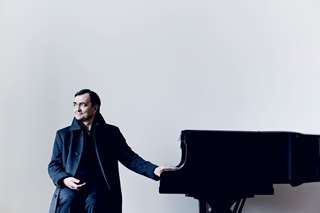|
Back
Pierre-Laurent Aimard Dazzles with the Orchestre symphonique de Montréal Montreal
Maison symphonique de Montréal, Place des Arts
10/30/2019 - & October 31, 2019
Ludwig van Beethoven: Leonore Overture No. 3, Op. 72b
Béla Bartók: Piano Concerto No. 1, Sz. 83
Richard Strauss: Ein Heldenleben, Op. 40
Pierre-Laurent Aimard (Piano)
Orchestre symphonique de Montréal, François-Xavier Roth (Conductor)

P.-L. Aimard (© Marco Borggreve)
The quality of orchestral playing in a single concert can turn on a dime. Wednesday evening’s offering from the Orchestre symphonique de Montréal, under guest conductor François-Xavier Roth, began with an incoherent performance of Beethoven’s Leonore Overture No. 3. An uneven and overly abrupt beginning was followed by exaggerated dynamics, more raggedy entries, baying horns and lack of dramatic line. The noisy conclusion seemed intended to whip the audience into a frenzy, which was accomplished with flying colours.
Bartók’s Piano Concerto No. 1 with pianist Pierre-Laurent Aimard, on the other hand, was sensational. The first (1926) of Bartók’s three piano concertos is the most modern, least melodic and least played. Its themes are more rhythmic than melodic, with myriad changes in tempo, treacherous runs and chords, and a continuously changing rhythmic dialogue between piano and orchestra, especially the percussion section. The four percussionists placed in front of the strings enabled the audience to better appreciate the interplay between them and the other musicians. Understandably, given the difficulty of the work and its infrequent performance, Aimard read from the score, which in no way detracted from his performance. His technique was crisp, articulate, with nuanced attention to each detail. The rhythmic pulse never let up—from a sizzling opening movement, to a melancholic and mysterious second to a dazzling third with its fiendishly fast chordal progressions. Orchestra and pianist were perfectly synchronized.
It was Roth’s turn to dazzle with Richard Strauss’s A Hero’s Life (1898). One of the longest of his tone poems, the composer set out a tongue-in-cheek narrative of his own life’s struggles in six sections—depictions of a hero (Strauss himself), his adversaries (the critics), his companion (his wife), the battlefield, the hero’s peaceful recollection of past accomplishments, and finally, his retreat from the world. Eschewing the baton, Roth used his body to sculpt the performance—leaning in, waving his arms and jumping into the air. With an augmented orchestra of over 100 musicians (including eight horns), Roth maintained firm control and a flowing architectural arc throughout. Shimmering strings, burnished brass, tight woodwinds and an impressive percussion section all contributed to the captivating performance. Notable moments included Andrew Wan’s lovingly-rendered violin solos (representing Strauss’s wife Pauline), the off-stage fanfare of three trumpets, the cacophonous battle scene which included the clash of three pairs of large cymbals, the silky sound from the harps and the soft denouement as the hero contemplates his last moments.
Earl Arthur Love
|